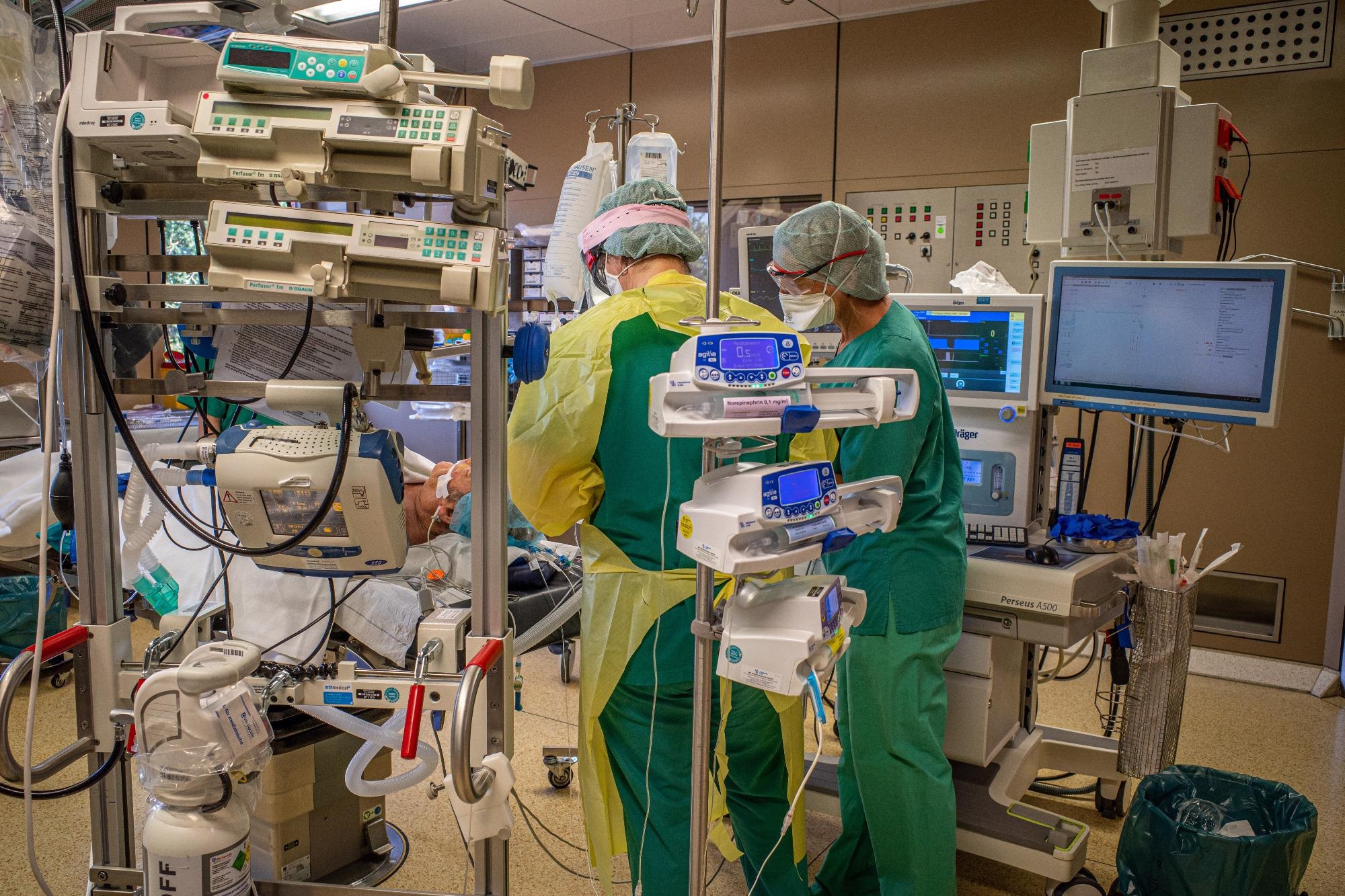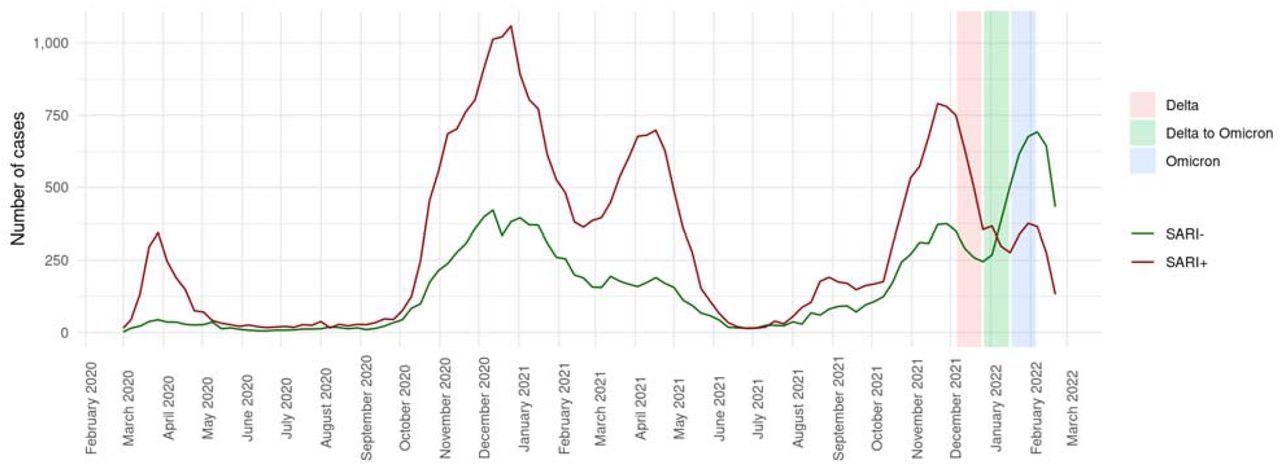In a recent study posted to the medRxiv* preprint server, researchers compared the outcomes and characteristics of hospitalized severe acute respiratory syndrome coronavirus 2 (SARS-CoV-2) patients during the SARS-CoV-2 Delta and Omicron variants’ dominant periods in Germany.
 Study: Characteristics and outcomes of COVID-19 patients during B.1.1.529 (Omicron) dominance compared to B.1.617.2 (Delta) in 89 German hospitals. Image Credit: karegg / Shutterstock
Study: Characteristics and outcomes of COVID-19 patients during B.1.1.529 (Omicron) dominance compared to B.1.617.2 (Delta) in 89 German hospitals. Image Credit: karegg / Shutterstock

 This news article was a review of a preliminary scientific report that had not undergone peer-review at the time of publication. Since its initial publication, the scientific report has now been peer reviewed and accepted for publication in a Scientific Journal. Links to the preliminary and peer-reviewed reports are available in the Sources section at the bottom of this article. View Sources
This news article was a review of a preliminary scientific report that had not undergone peer-review at the time of publication. Since its initial publication, the scientific report has now been peer reviewed and accepted for publication in a Scientific Journal. Links to the preliminary and peer-reviewed reports are available in the Sources section at the bottom of this article. View Sources
Background
The SARS-CoV-2 B.1.1.529 (Omicron) variant of concern (VOC) was initially reported in late November 2021, and it rapidly became the most prevalent variant around the world. Existing reports indicate that Omicron induces a less severe form of coronavirus disease 2019 (COVID-19) than the previous globally dominant SARS-CoV-2 B.1.617.2 (Delta) VOC.
Data on variations in features and in-hospital outcomes of COVID-19 patients in Germany during Omicron dominancy relative to Delta dominancy are not carefully evaluated. Further, monitoring for severe acute respiratory infections (SARI) is a critical feature of infectious disease control in Germany.
About the study
In the present study, the researchers evaluated the outcomes and characteristics of hospitalized COVID-19 patients in Germany and estimated Omicron-induced COVID-19 severity, and the temporal patterns during the B.1.617.2 to B.1.1.529 transition period. For this, the team examined the SARI frequency in COVID-19 patients.
The scientists retrospectively analyzed the administrative data obtained from 89 German Helios hospitals. While laboratory-confirmed COVID-19 cases were defined by the International Statistical Classification of Diseases and Related Health Problems Version 10, German Modification-code U07.1 (ICD-10-GM-code U07.1), SARI patients were identified by ICD-10-codes J09-J22. Furthermore, SARS-CoV-2-infected patients were categorized by coinciding SARI, i.e., 1) SARI+ (COVID-19 with SARI) and 2) SARI- (COVID-19 without SARI). In total, 4,494 in-patients were assessed in this investigation.
Considering the dominating SARS-CoV-2 variant (B.1.617.2, B.1.617.2 to B.1.1.529 transition, and B.1.1.529), a nine-week observational timeframe was designed and split into three stages between December 6, 2021, and February 6, 2022, in this study. In in-hospital COVID-19 patients, the outcomes were assessed using regression analysis and controlled for gender, Elixhauser comorbidities, and age.

COVID-19 cases since the beginning of 2020 are stratified by encoded SARI. The colored bars represent three phases with respect to the dominating SARS-CoV-2 variants. SARI = Severe Acute Respiratory Infection; SARI- = COVID-19 without SARI; SARI+ = COVID-19 with SARI
Results and discussions
The study results displayed that SARI was frequent among SARS-CoV-2 patients, with the first four COVID-19 pandemic waves showing the highest occurrence rates. Nevertheless, SARI- patients outnumbered SARI+ patients during the Delta to Omicron transition period. The percentage of SARI+ patients reduced from 64.3% in the Delta dominant period to 30.6% in the Omicron dominant period.
Further, the findings demonstrated a dramatic change in COVID-19 patient features in the Omicron dominant period. COVID-19 patients in the Omicron dominant period were younger, female, and had reduced comorbidities than in the Delta dominant period. The mean age of the total SARS-CoV-2 cohort declined from 61.6 to 47.8 years with the Delta-to-Omicron-transition.
During the Omicron dominancy, the COVID-19 patients in the SARI+ group were older than the SARI- cohort. Further, the percentage of male COVID-19 patients declined substantially for the total cohort. The overall cohort had a substantial decline in the mean weighted Elixhauser comorbidity index of 8.2 during the Delta dominant period and 5.4 in the Omicron dominant period, and the SARI- cohort, while not the SARI+ cohort.
SARS-CoV-2 patients during the Omicron dominant period Swere less likely to require intensive care unit (ICU) admission and mechanical ventilation, and they had a decreased mortality risk in the entire cohort and the SARI+ cohorts than in the Delta dominant period. In contrast, no drastic risk lowering was observed in the SARI- group for ICU treatment and mechanical ventilation during the Omicron dominant period, whereas the in-hospital deaths were reduced. Further, the duration of mechanical ventilation, ICU stay, and hospital stay dropped in the total cohort during the Omicron dominant period compared to that of Delta. Similarly, the length of hospital stay and mechanical ventilation duration were reduced in the SARI+ cohort.
Hence, the authors stated that Omicron possibly induces less severe COVID-19. The simultaneous occurrence of SARI appears to be linked to the severity of COVID-19 in hospitalized patients. As a result, SARI surveillance might be critical for the COVID-19 pandemic surveillance.
Conclusions
According to the authors, this was the first study comparing COVID-19 patient outcomes during the SARS-CoV-2 pandemic fourth and fifth waves in Germany based on the dominating viral VOCs.
The study findings indicated that the COVID-19 patients during the Omicron dominant period were younger, more likely to be females, and had a lower comorbidity load than in the Delta dominant period. SARS-CoV-2 patients had a substantially decreased risk for mechanical ventilation, in-hospital death, and ICU treatment in the Omicron dominant period compared to that of Delta. This finding was likewise true for the SARI+ cohort. Furthermore, the SARI- cohort had more cases than SARI+ during the Delta-to-Omicron-transition period and the Omicron dominant period.
Overall, the present work illustrated that COVID-19 patient features and outcomes varied during the Omicron dominant period versus the Delta dominant period, indicating that Omicron infections were less severe. Further, the study states that persistent ICD-code-based SARI monitoring might be critical in COVID-19 surveillance and determining the severity of future SARS-CoV-2 mutant strains. Nonetheless, further studies are required to corroborate this observation.

 This news article was a review of a preliminary scientific report that had not undergone peer-review at the time of publication. Since its initial publication, the scientific report has now been peer reviewed and accepted for publication in a Scientific Journal. Links to the preliminary and peer-reviewed reports are available in the Sources section at the bottom of this article. View Sources
This news article was a review of a preliminary scientific report that had not undergone peer-review at the time of publication. Since its initial publication, the scientific report has now been peer reviewed and accepted for publication in a Scientific Journal. Links to the preliminary and peer-reviewed reports are available in the Sources section at the bottom of this article. View Sources
Journal references:
- Preliminary scientific report.
Characteristics and outcomes of COVID-19 patients during B.1.1.529 (Omicron) dominance compared to B.1.617.2 (Delta) in 89 German hospitals; Johannes Leiner, Vincent Pellissier, Sven Hohenstein, Sebastian Koenig, Ekkehard Schuler, Robert Moeller, Irit Nachtigall, Marzia Bonsignore, Gerhard Hindricks, Ralf Kuhlen, ANDREAS BOLLMANN, medRxiv preprint 2022, DOI: https://doi.org/10.1101/2022.04.09.22273420, https://www.medrxiv.org/content/10.1101/2022.04.09.22273420v1
- Peer reviewed and published scientific report.
Leiner, Johannes, Vincent Pellissier, Sven Hohenstein, Sebastian König, Ekkehard Schuler, Robert Möller, Irit Nachtigall, et al. 2022. “Characteristics and Outcomes of COVID-19 Patients during B.1.1.529 (Omicron) Dominance Compared to B.1.617.2 (Delta) in 89 German Hospitals.” BMC Infectious Diseases 22 (1). https://doi.org/10.1186/s12879-022-07781-w. https://bmcinfectdis.biomedcentral.com/articles/10.1186/s12879-022-07781-w.
Article Revisions
- May 12 2023 - The preprint preliminary research paper that this article was based upon was accepted for publication in a peer-reviewed Scientific Journal. This article was edited accordingly to include a link to the final peer-reviewed paper, now shown in the sources section.